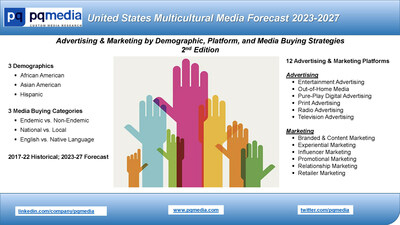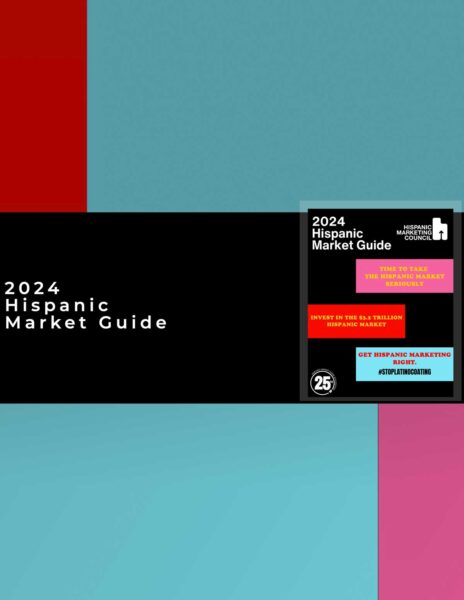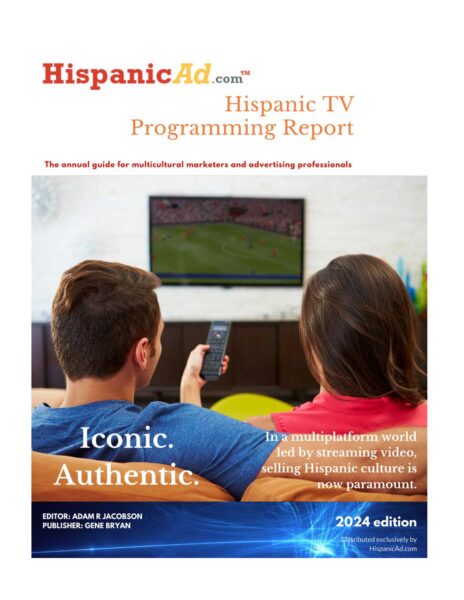US Multicultural Media Spend to Grow at Accelerated 8.3% to 45.8B in 2024, as Hispanic, African & Asian American Markets Benefit from Influx of Political & Sports Dollars
January 3, 2024

United States multicultural advertising and marketing spending, including Hispanic, African and Asian American markets, is expected to surge 8.4% to a record $45.83 billion in 2024, following decelerating growth of 5.7% in 2023 compared with the strong upswing in 2022, according to new research released today by PQ Media, the world’s leading provider of media econometrics.

Much of the record growth and media spend projected in 2024 will be generated by the Hispanic segment of the multicultural market that is expected to be a major focus of political campaign budgets in a hotly contested US presidential election year. Hispanic media already commands 68.3% of multicultural media spend and accounts for more than double the combined share of the other two multiethnic demographics – African-American (28.8% share) and Asian-American (2.9% share) – although both segments are forecast to post accelerated growth of nearly 8% in 2024, according to PQ Media’s United States Multicultural Media Forecast 2023-2027.
The primary beneficiary of this shift is projected to be the Hispanic American market, which is expected to be one of the most important constituents of any political candidate seeking a high state or federal office in 2024, particularly in the largest states with the most votes.
But while multicultural media generated strong growth in 2022 – as did most US media segments, particularly those that shined in the multicultural segments, such as experiential marketing, influencer marketing, content marketing, out-of-home advertising and pure-play digital media – growth slowed in 2023 across the multiethnic media sector due to several key variables. Among them, fears of an impending economic recession that never materialized; the US Supreme Court reversing its ruling on affirmative action at universities; and the reaction of the “Woke” movement, which led to negative financial impacts on major US brands, such as Target and Bud Light.
As a result, many of PQ Media’s diverse Global Opinion Leader Panelists reported that multicultural media budgets were reduced in 2023, particularly by newer emerging brands. Nevertheless, the strong positive momentum in these growing markets is outweighing the negative events occurring on the perimeter. For example, multicultural media financial investments have begun to increase in late 2023 and into 2024, such as The Pivot Fund aimed at expanding minority news sources. Additionally, political media buying – both advertising and marketing – on multicultural media outlets is projected to surge in 2024.
In the meantime, overall multicultural media spending in the US accounted for only 5.3% of total US ad & marketing spend in 2023, a minor uptick from the 5.2% share acquired in 2017. To put this into context, consider that multicultural consumers make up nearly 40% of the total US population. So, while Hispanic, African and Asian Americans combined have constituted the fastest growing demographic in the country for years, multicultural media growth has conversely underperformed the broader US media industry and still accounts for a mere sliver of the overall American pie.
However, PQ Media analysts see this changing progressively during the next several years, as experiential marketing, influencer marketing, content marketing, out-of-home advertising and pure-play digital advertising are set to post their highest growth rates of all time in, not only the multicultural media sector, but the overall US ad & marketing industry.
And the primary beneficiary of this shift is projected to be the Hispanic American market, which is expected to be one of the most important constituents of any political candidate seeking a high state or federal office in 2024, particularly in the largest states with the most votes, such as Florida, Texas and California. For instance, Hispanic-targeted radio stations are projecting a 25% gain to $41 million in the 2024 US political cycle, as candidates seek to reach more of the growing Hispanic electorate.
Projecting out further, PQ Media’s research indicates there is growing anticipation around FIFA’s 2026 World Cup in North America, which may completely disrupt the US soccer landscape, firmly positioning the country on the map as a soccer powerhouse.
“Liga MX’s US commercial rights have found an exclusive home with TelevisaUnivision, creating an historic partnership and elevating the company’s position as the premier destination for brands looking to integrate into the world of soccer, leading to a deeper and growing appeal of the soccer culture among major brands,” said PQ Media CEO & Founder Patrick Quinn. “In short, the 2026 FIFA World Cup could be the phenomenon that finally supercharges the multicultural markets – and particularly the largest and fastest growing demographic therein, Hispanic Americans – into the double-digit range of total US media spend for the first time ever.”
According to PQ Media’s new research, spending on overall multicultural television is projected to increase 2.3% in 2023 to $9.65 billion, making TV the largest multiethnic medium. Ranking as second largest is relationship marketing, which is expected to rise 1.3% in 2023 to $5.31 billion, followed by pure-play digital media, which is forecast to grow 10.5% $4.97 billion, according to the US Multicultural Media Forecast 2023-2027.
Meanwhile, the fastest growing multicultural media in 2023 were Experiential Marketing, which is on pace to grow 15.2% to $3.54 billion this year, followed by Influencer Marketing, which is projected to jump 13.6% to $1.78 billion, and Branded & Content Marketing, which is set to end this year with an 11.8% expansion to $1.50 billion, according to PQ Media.






























